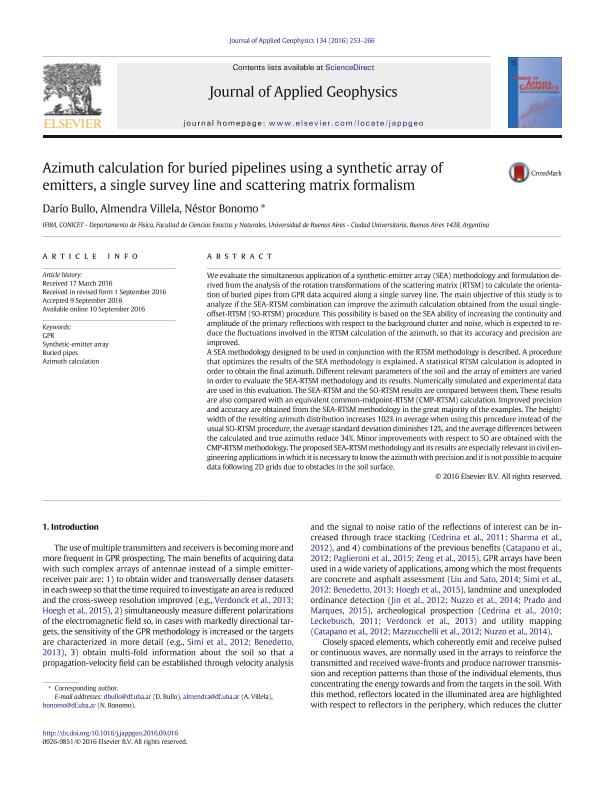Artículo
Azimuth calculation for buried pipelines using a synthetic array of emitters, a single survey line and scattering matrix formalism
Fecha de publicación:
11/2016
Editorial:
Elsevier Science
Revista:
Journal Of Applied Geophysics
ISSN:
0926-9851
Idioma:
Inglés
Tipo de recurso:
Artículo publicado
Clasificación temática:
Resumen
We evaluate the simultaneous application of a synthetic-emitter array (SEA) methodology and formulation derived from the analysis of the rotation transformations of the scattering matrix (RTSM) to calculate the orientation of buried pipes from GPR data acquired along a single survey line. The main objective of this study is to analyze if the SEA-RTSM combination can improve the azimuth calculation obtained from the usual single-offset-RTSM (SO-RTSM) procedure. This possibility is based on the SEA ability of increasing the continuity and amplitude of the primary reflections with respect to the background clutter and noise, which is expected to reduce the fluctuations involved in the RTSM calculation of the azimuth, so that its accuracy and precision are improved. A SEA methodology designed to be used in conjunction with the RTSM methodology is described. A procedure that optimizes the results of the SEA methodology is explained. A statistical RTSM calculation is adopted in order to obtain the final azimuth. Different relevant parameters of the soil and the array of emitters are varied in order to evaluate the SEA-RTSM methodology and its results. Numerically simulated and experimental data are used in this evaluation. The SEA-RTSM and the SO-RTSM results are compared between them. These results are also compared with an equivalent common-midpoint-RTSM (CMP-RTSM) calculation. Improved precision and accuracy are obtained from the SEA-RTSM methodology in the great majority of the examples. The height/width of the resulting azimuth distribution increases 102% in average when using this procedure instead of the usual SO-RTSM procedure, the average standard deviation diminishes 12%, and the average differences between the calculated and true azimuths reduce 34%. Minor improvements with respect to SO are obtained with the CMP-RTSM methodology. The proposed SEA-RTSM methodology and its results are especially relevant in civil engineering applications in which it is necessary to know the azimuth with precision and it is not possible to acquire data following 2D grids due to obstacles in the soil surface.
Palabras clave:
Azimuth Calculation
,
Buried Pipes
,
Gpr
,
Synthetic-Emitter Array
Archivos asociados
Licencia
Identificadores
Colecciones
Articulos(IFIBA)
Articulos de INST.DE FISICA DE BUENOS AIRES
Articulos de INST.DE FISICA DE BUENOS AIRES
Citación
Bullo, Darío Ezequiel; Villela, Almendra; Bonomo, Nestor Eduardo; Azimuth calculation for buried pipelines using a synthetic array of emitters, a single survey line and scattering matrix formalism; Elsevier Science; Journal Of Applied Geophysics; 134; 11-2016; 253-266
Compartir
Altmétricas




